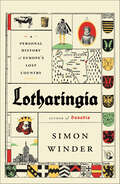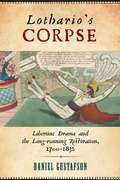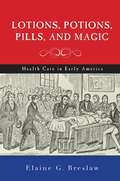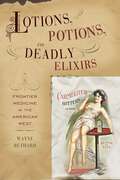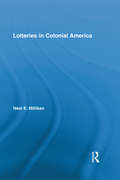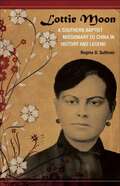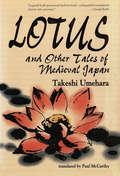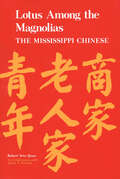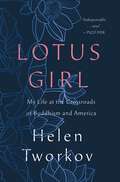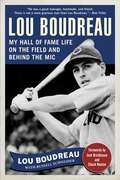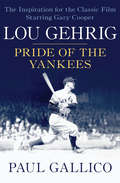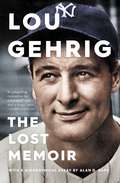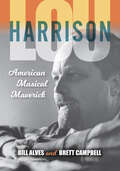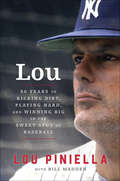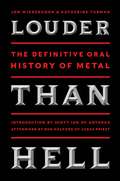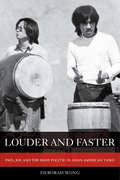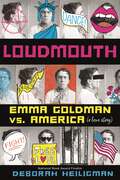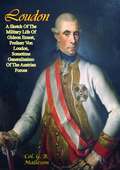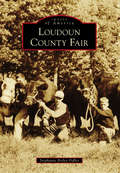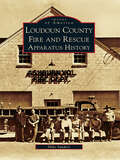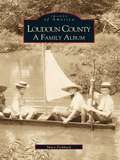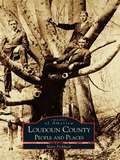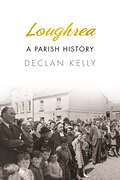- Table View
- List View
Lotharingia: A Personal History of Europe's Lost Country
by Simon WinderFollowing Germania and Danubia, the third installment in Simon Winder’s personal history of EuropeIn 843 AD, the three surviving grandsons of the great emperor Charlemagne met at Verdun. After years of bitter squabbles over who would inherit the family land, they finally decided to divide the territory and go their separate ways. In a moment of staggering significance, one grandson inherited the area we now know as France, another Germany and the third received the piece in between: Lotharingia.Lotharingia is a history of in-between Europe. It is the story of a place between places. In this beguiling, hilarious and compelling book, Simon Winder retraces the various powers that have tried to overtake the land that stretches from the mouth of the Rhine to the Alps and the might of the peoples who have lived there for centuries.
Lothario's Corpse: Libertine Drama and the Long-Running Restoration, 1700-1832 (Transits: Literature, Thought & Culture 1650-1850)
by Daniel GustafsonLothario’s Corpse unearths a performance history, on and off the stage, of Restoration libertine drama in Britain’s eighteenth and early nineteenth centuries. While standard theater histories emphasize libertine drama’s gradual disappearance from the nation’s acting repertory following the dispersal of Stuart rule in 1688, Daniel Gustafson traces its persistent appeal for writers and performers wrestling with the powers of the emergent liberal subject and the tensions of that subject with sovereign absolutism. With its radical, absolutist characters and its scenarios of aristocratic license, Restoration libertine drama became a critical force with which to engage in debates about the liberty-loving British subject’s relation to key forms of liberal power and about the troubling allure of lawless sovereign power that lingers at the heart of the liberal imagination. Weaving together readings of a set of literary texts, theater anecdotes, political writings, and performances, Gustafson illustrates how the corpse of the Restoration stage libertine is revived in the period’s debates about liberty, sovereign desire, and the subject’s relation to modern forms of social control. Ultimately, Lothario’s Corpse suggests the “long-running” nature of Restoration theatrical culture, its revived and revised performances vital to what makes post-1688 Britain modern. Published by Bucknell University Press. Distributed worldwide by Rutgers University Press.
Lotions, Potions, Pills, and Magic: Health Care in Early America
by Elaine G. BreslawHealth in early America was generally good. The food was plentiful, the air and water were clean, and people tended to enjoy strong constitutions as a result of this environment. Practitioners of traditional forms of health care enjoyed high social status, and the cures they offered—from purging to mere palliatives—carried a powerful authority. Consequently, most American doctors felt little need to keep up with Europe’s medical advances relying heavily on their traditional depletion methods. However, in the years following the American Revolution as poverty increased and America’s water and air became more polluted, people grew sicker. Traditional medicine became increasingly ineffective. Instead, Americans sought out both older and newer forms of alternative medicine and people who embraced these methods: midwives, folk healers, Native American shamans, African obeahs and the new botanical and water cure advocates.In this overview of health and healing in early America, Elaine G. Breslaw describes the evolution of public health crises and solutions. Breslaw examines “ethnic borrowings” (of both disease and treatment) of early American medicine and the tension between trained doctors and the lay public. While orthodox medicine never fully lost its authority, Lotions, Potions, Pills, and Magic argues that their ascendance over other healers didn’t begin until the early twentieth century, as germ theory finally migrated from Europe to the United States and American medical education achieved professional standing.
Lotions, Potions, and Deadly Elixirs: Frontier Medicine in the American West
by Wayne BethardPowder papers, booty balls, and sugar tits— Lotions, Potions, and Deadly Elixirs has a cure for whatever ails! These quaint names were given to popular medicinal forms during America's frontier era that were said to cure everything from fallen arches to a broken windmill. Grandmas, mommas, and even certified physicians treated the sick, lame, and unlucky with what was available: barbed wire and horseshoe nails, cactus, pokeweed, buckeyes, you name it. Ironically, a lot of these homespun treatments actually worked. In Lotions, Potions, and Deadly Elixirs, a practicing pharmacist takes a light-hearted look at the most popular medicines from the frontier days and how they were intended to work. An authoritative "Frontier Materia Medica" lists common drugs, the dates they were in use, customary doses, and idiosyncrasies. The author's outstanding collection of bottle labels, advertising art, and rare photographs of "medicine shows" rounds out this colorful survey of America's medicinal past.
Lotteries in Colonial America (Studies in American Popular History and Culture)
by Neal MillikanLotteries in Colonial America explores lotteries in England and the American colonies in the seventeenth and eighteenth centuries. From the founding of Jamestown to the financing of the American Revolution, lotteries played an important role in the economic life of the colonies. Lotteries provided an alternative form of raising money for colonial governments and a means of subsidizing public and private projects without enacting new taxes. The book also describes and analyzes the role of lotteries in the eighteenth-century consumer revolution, which transformed how buyers viewed the goods they purchased, or in the case of lotteries, won. As the middling classes in the colonies began to acquire objects that went beyond mere necessities, lotteries gave colonists an opportunity to risk a small sum in the hopes of gaining riches or valuable goods. Finally, the book examines how lotteries played a role in the changing notions of fortune in colonial America. Religion and chance were present in colonial lotteries as participants merged their own free will to purchase a lottery ticket with the will of the Christian God to select a winner.
Lottie Moon: A Southern Baptist Missionary to China in History and Legend (Southern Biography Series)
by Regina D. SullivanLegendary Southern Baptist missionary Charlotte "Lottie" Moon played a pivotal role in revolutionizing southern civil society. Her involvement in the establishment of the Women's Missionary Union provided white Baptist women with an alternate means of gaining and asserting power within the denomination's organizational structure and changed it forever. In Lottie Moon: A Southern Baptist Missionary to China in History and Legend Regina Sullivan provides the first comprehensive portrait of "Lottie," who not only empowered women but also inspired the formation of one of the most influential religious organizations in the United States.Despite being the daughter of slaveholders in antebellum Virginia, Moon never lived the life of a typical southern belle. Highly educated and influenced by models of independent womanhood, including an older sister who was a woman's rights advocate, an open opponent of slavery, and the first Virginian female to earn a medical degree, Moon followed her sister's lead and utilized her extensive education to successfully combine the language of woman's rights with the egalitarian impulse of evangelical Protestantism.In 1873 Moon found her true calling, however, in missionary work in China. During her tenure there she recommended that the week before Christmas be designated as a time of giving to foreign missions. In response to her vision, thousands of Southern Baptist women organized local missionary societies to collect funds, and in 1888, the Woman's Missionary Union was founded as the Southern Baptist Convention's female auxiliary for missionary work.Sullivan credits Moon's role in the establishment of the Woman's Missionary Union as having a significant impact on the erosion of patriarchal power and women's new engagement with the public sphere. Since her initial plea in 1888, the Missionary Union's annual "Lottie Moon Christmas Offering" has raised over a billion dollars to support missionary work.Lottie Moon captures the influence and culminating effect of one woman's personal, spiritual, and civic calling.
Lotus & Other Tales of Medieval Japan
by Paul Mccarthy Takeshi UmeharaThe medieval period in Japan, spanning the years from about 1200 to 1600, was a time of rapid cultural development that saw the emergence and refinement of many new art forms. One of these was the religious folk tale, or setsuwa, many collections of which were compiled during this time. Unlike the rarified court poems and accounts of aristocratic life written during this period, setsuwa were literature for the common man. Like the classic fables and parables of the West, these stories are varied in origin, many of them collected from Indian and Chinese sources and retold and embellished by succeeding generations of authors. In Lotus: and Other Tales of Medieval Japan, the author has carefully chosen eight particularly notable setsuwa for their timeless interest and fascinating plot developments.
Lotus & Other Tales of Medieval Japan
by Paul Mccarthy Takeshi UmeharaThe medieval period in Japan, spanning the years from about 1200 to 1600, was a time of rapid cultural development that saw the emergence and refinement of many new art forms. One of these was the religious folk tale, or setsuwa, many collections of which were compiled during this time. Unlike the rarified court poems and accounts of aristocratic life written during this period, setsuwa were literature for the common man. Like the classic fables and parables of the West, these stories are varied in origin, many of them collected from Indian and Chinese sources and retold and embellished by succeeding generations of authors. In Lotus: and Other Tales of Medieval Japan, the author has carefully chosen eight particularly notable setsuwa for their timeless interest and fascinating plot developments.
Lotus Among the Magnolias: The Mississippi Chinese
by Robert Seto QuanUnlike most Chinese-American studies which focus on large urban concentrations sustained by continuous immigration, this study centers on a small Chinese enclave located in a rural southern biracial society. It focuses upon three generations of Chinese undergoing social change in an area within the state of Mississippi known as the Delta. This isolated group of people, having little contact with other US Chinese communities, remained nearly intact through the first two generations. Now great changes have caused the third generation to leave the enclave and to relinquish many ethnic traditions. Lotus Among the Magnolias, a story recorded firsthand by a Chinese scholar who lived among the Mississippi Delta Chinese, is an ethnography about how the Chinese were initially classified by the whites as “colored,” and later came to be viewed as a people with a separate identity. As their image has changed, so too have many values and traditions in their lives. This study shows how these Chinese have been able to expand their social and economic potential and are now moving away from their restrictive beginnings.
Lotus Girl: My Life at the Crossroads of Buddhism and America
by Helen TworkovFrom one of the central figures in Buddhism's introduction to the West and the founder of Tricycle magazine comes a brilliant memoir of forging one’s own path that Pico Iyer calls "unflinching" and "indispensable." The daughter of an artist, Helen Tworkov grew up in the heady climate of the New York School of Abstract Expressionism; yet from an early age, she questioned the value of Western cultural norms. Her life was forever changed when she saw the iconic photo of Thich Quang Duc, the Vietnamese monk who, seated in meditation, set himself on fire to protest his government’s crackdown on the Buddhist clergy. Tworkov realized that radically different states of mind truly existed and were worth exploring. At the age of twenty-two, she set off for Japan, then traveled through Cambodia, India, and eventually to Tibetan refugee camps in Nepal. Set against the arresting cultural backdrop of the sixties and their legacy, this intimate self-portrait depicts Tworkov's search for a true home as she interacts with renowned artists and spiritual luminaries including the Dalai Lama, Pema Chödrön, Joseph Goldstein, Bernie Glassman, Charles Mingus, Elizabeth Murray and Richard Serra. Interweaving experience, research, and revelation, Helen Tworkov explores the relationship between Buddhist wisdom and American values, presenting a wholly unique look at the developing landscape of Buddhism in the West. Lotus Girl offers insight not only into Tworkov's own search for the truth, but into the ways each of us can better understand and transform ourselves.
Lou Boudreau: My Hall of Fame Life on the Field and Behind the Mic
by Russell Schneider Lou Boudreau Jack Brickhouse Chuck HeatonThe autobiography of a baseball great.Lou Boudreau is considered one of the most extraordinary men in baseball history. He was a player-manager, an All Star, an MVP, a World Series-winner, and a Hall of Famer. But that only scratches the surface of "The Good Kid.” In Lou Boudreau: Covering All the Bases, hear from his own words the personal story of a boy from Harvey, Illinois, and how he took the sport of baseball my storm.In 1942, at only twenty-four years of age and with less than three full seasons in the major leagues, Boudreau was named as the team’s next manager. He took the role seriously, and made sure to always lead by example. Lou also shares stories of playing with and managing Cleveland’s first African American players, Larry Doby and Satchel Paige, and of winning the 1944 American League Batting Championship with a hit in his final at bat of the season. But the highlight of Lou’s career came in 1948, when he used his bat, glove, and coaching skills to lead the Indians to a World Series victory, while becoming the only player-manager ever to win the American League MVP award.Retiring as a ballplayer in 1952, Boudreau coached for eight more seasons before finally walking away from the field in 1960. He then began his second career as a broadcaster, and was the "Voice of the Chicago Cubs” for almost thirty years.On August 10, 2001, Lou Boudreau passed away at the age of eighty-four. Enshrined in the National Baseball Hall of Fame, "The Good Kid” will always be remembered for what he did both on and off the field. As former teammate and Hall of Famer Bob Feller once said, "He was a great manager, teammate, and friend. There is not a more gracious man than Lou Boudreau.”
Lou Gehrig: Pride of the Yankees
by Paul GallicoA touching tribute to one of the greatest ballplayers of all time For seventeen seasons, Lou Gehrig was the heart and soul of the New York Yankees. The power-hitting first baseman donned the pinstripes for 2,130 consecutive games, a streak that earned him the nickname "the Iron Horse" and went unbroken for more than five decades. World Series champion, All-Star, American League Most Valuable Player, Triple Crown winner--the list of Gehrig's on-field achievements is spectacular. But he is best remembered for the grace and the strength with which he faced an insurmountable challenge off the field: the disease that ended his career and which now bears his name. When he retired on April 30, 1939, Lou Gehrig called himself "the luckiest man on the face of the earth." His words continue to resonate more than seventy-five years after they were spoken. In this heartfelt biography, which was the basis for the Academy Award-winning film The Pride of the Yankees, starring Gary Cooper, legendary sportswriter Paul Gallico tells the story of how a son of German immigrants rose to the pinnacle of greatness in America's pastime and inspired the nation as no other athlete ever has.
Lou Gehrig: The Lost Memoir
by Alan D. Gaff&“A compelling rumination by a baseball icon and a tragic hero.&” —Sports Illustrated The lost memoir from baseball icon Lou Gehrig—a sensational discovery, published for the first time as a book.At the tender age of twenty-four, Lou Gehrig decided to tell the remarkable story of his life and career. He was one of the most famous athletes in the country, in the midst of a record-breaking season with the legendary 1927 World Series-winning Yankees. In an effort to grow Lou&’s star, pioneering sports agent Christy Walsh arranged for Lou&’s tale of baseball greatness to syndicate in newspapers across the country. Until now, those columns were largely forgotten and lost to history. Lou comes alive in this inspiring memoir. It is a heartfelt rags-to-riches tale about a dirt poor kid from New York who became one of the most revered baseball players of all time. Fourteen years after his account, Lou would tragically die from ALS, a neuromuscular disorder now known as Lou Gehrig&’s Disease. His poignant autobiography is followed by an insightful biographical essay by historian Alan D. Gaff. Here is Lou—Hall of Famer, All Star, and MVP—back at bat.
Lou Harrison: American Musical Maverick
by Bill Alves Brett CampbellA biography on the legendary gay American composer of contemporary classical music.American composer Lou Harrison (1917–2003) is perhaps best known for challenging the traditional musical establishment along with his contemporaries and close colleagues: composers John Cage, Aaron Copland, Virgil Thomson, and Leonard Bernstein; Living Theater founder, Judith Malina; and choreographer, Merce Cunningham. Today, musicians from Bang on a Can to Björk are indebted to the cultural hybrids Harrison pioneered half a century ago. His explorations of new tonalities at a time when the rest of the avant-garde considered such interests heretical set the stage for minimalism and musical post-modernism. His propulsive rhythms and ground-breaking use of percussion have inspired choreographers from Merce Cunningham to Mark Morris, and he is considered the godfather of the so-called “world music” phenomenon that has invigorated Western music with global sounds over the past two decades.In this biography, authors Bill Alves and Brett Campbell trace Harrison’s life and career from the diverse streets of San Francisco, where he studied with music experimentalist Henry Cowell and Austrian composer Arnold Schoenberg, and where he discovered his love for all things non-traditional (Beat poetry, parties, and men); to the competitive performance industry in New York, where he subsequently launched his career as a composer, conducted Charles Ives’s Third Symphony at Carnegie Hall (winning the elder composer a Pulitzer Prize), and experienced a devastating mental breakdown; to the experimental arts institution of Black Mountain College where he was involved in the first “happenings” with Cage, Cunningham, and others; and finally, back to California, where he would become a strong voice in human rights and environmental campaigns and compose some of the most eclectic pieces of his career.“Lou Harrison’s avuncular personality and tuneful music coaxed affectionate regard from all who knew him, and that affection is evident on every page of Alves and Campbell’s new biography. Eminently readable, it puts Harrison at the center of American music: he knew everyone important and was in touch with everybody, from mentors like Henry Cowell and Arnold Schoenberg and Charles Ives and Harry Partch and Virgil Thomson to peers like John Cage to students like Janice Giteck and Paul Dresher. He was larger than life in person, and now he is larger than life in history as well.” —Kyle Gann, author of Charles Ives’s Concord: Essays After a Sonata
Lou: Fifty Years of Kicking Dirt, Playing Hard, and Winning Big in the Sweet Spot of Baseball
by Bill Madden Lou PiniellaIn this candid, revealing, and entertaining memoir, the beloved New York Yankee legend looks back over his nearly fifty-year career as a player and a manager, sharing insights and stories about some of his most memorable moments and some of the biggest names in Major League Baseball.For nearly five decades, Lou Piniella has been a fixture in Major League Baseball, as an outfielder with the legendary New York Yankees of the 1970s, and as a manager for five teams in both the American and National leagues. With respected veteran sportswriter Bill Madden, Piniella now reflects on his storied career, offering fans a glimpse of life on the field, in the dugout, and inside the clubhouse.Piniella speaks from the heart about his teams and his players, offering a detailed, up-close portrait of the Bronx Zoo’s raucous personalities such as Reggie Jackson and Catfish Hunter, as well as his close friendship with Thurman Munson and his unusual relationship with George Steinbrenner. He also delves deep into his post-Yankee experiences, from winning a World Series for the controversial owner of the Cincinnati Reds, Marge Schott, to transforming the perennial cellar-dwelling Seattle Mariners into one of the league’s best teams. Some of the game’s brightest stars are here: Ken Griffey Jr, Randy Johnson, and Alex Rodriguez, Piniella’s supremely talented and controversial protégé. Throughout his time in the majors, Piniella has witnessed MLB grow into a multi-billion-dollar business. Piniella reflects on those changes, voicing his highly critical opinions on a range of controversial subjects, including steroids. Hilarious and uproarious, filled with eight pages of photos, Lou brings into focus a man whose deeply rooted passion for baseball has defined his life.
Louder Than Hell: The Definitive Oral History of Metal
by Jon Wiederhorn Katherine TurmanThe definitive oral history of heavy metal, Louder Than Hell by renowned music journalists Jon Wiederhorn and Katherine Turman includes hundreds of interviews with the giants of the movement, conducted over the past 25 years. Unlike many forms of popular music, metalheads tend to embrace their favorite bands and follow them over decades. Metal is not only a pastime for the true aficionados; it’s a lifestyle and obsession that permeates every aspect of their being. Louder Than Hell is an examination of that cultural phenomenon and the much-maligned genre of music that has stood the test of time. Louder than Hell features more than 250 interviews with some of the biggest bands in metal, including Black Sabbath, Metallica, Megadeth, Anthrax, Slayer, Iron Maiden, Judas Priest, Spinal Tap, Pantera, White Zombie, Slipknot, and Twisted Sister; insights from industry insiders, family members, friends, scenesters, groupies, and journalists.
Louder and Faster: Pain, Joy, and the Body Politic in Asian American Taiko (American Crossroads #55)
by Deborah WongA free open access ebook is available upon publication. Learn more at www.luminosoa.org.Louder and Faster is a cultural study of the phenomenon of Asian American taiko, the thundering, athletic drumming tradition that originated in Japan. Immersed in the taiko scene for twenty years, Deborah Wong has witnessed cultural and demographic changes and the exponential growth and expansion of taiko particularly in Southern California. Through her participatory ethnographic work, she reveals a complicated story embedded in memories of Japanese American internment and legacies of imperialism, Asian American identity and politics, a desire to be seen and heard, and the intersection of culture and global capitalism. Exploring the materialities of the drums, costumes, and bodies that make sound, analyzing the relationship of these to capitalist multiculturalism, and investigating the gender politics of taiko, Louder and Faster considers both the promises and pitfalls of music and performance as an antiracist practice. The result is a vivid glimpse of an Asian American presence that is both loud and fragile.
Loudmouth: Emma Goldman vs. America (A Love Story)
by Deborah HeiligmanBoth a love letter to America and a stirring rallying cry for the country to live up to the ideals on which it was founded, this propulsive biography from National Book Award Finalist and “nonfiction maestro (Horn Book)" Deborah Heiligman chronicles the extraordinary life and work of groundbreaking political activist Emma Goldman.★ “Heiligman’s latest . . . solidifies her as one of the absolute best in the business . . . Loudmouth is a master class.” —Booklist, starred reviewEmma Goldman made trouble her whole life. The first time was by accident. Her birth (in Lithuania, in 1869) angered her father. He had wanted a dutiful son, not a headstrong daughter. The other times were on purpose.When she arrived in America as a young woman, she loved its democratic ideals but was appalled by its hypocrisy. Life, liberty, and the pursuit of happiness seemed to be only for those at the top. Something had to be done for everyone else. Someone had to speak up. Soon Emma was delivering rousing speeches on topics like workers’ rights, feminism, and the atrocities of capitalism.This is the story of Emma’s complex love affair with America. It’s also the story of her many romances with the men she met while trying to change America. Emma believed marriage was disempowering to women and lived her life according to the principles of free love.Emma called herself an anarchist and a freethinker. Her critics called her a troublemaker, a “loudmouth.” But sometimes you need to be loud, if you want your voice to be heard.Deborah Heiligman is a National Book Award finalist, a YALSA Nonfiction Award winner, and a Printz Honor winner. In Loudmouth she tells the extraordinary true story of a woman who was a fearsome fighter for change in her complicated new country—and a complicated human being in her own right. This is an essential read for young people—or for anyone—who wants to use their voice to make the world a better place.
Loudon: Sometime Generalissimo Of The Austrian Forces
by Col. G. B. MallesonFew Generals left such a shining legacy of military genius and glory than Frederick the Great and his Prussian army, however, this reputation was hard fought and grimly won against the forces of Austria. The leading Austrian general, who frustrated many of Frederick's designs, was General Frieherr von Loudon, a soldier through and through. In this detailed biography, noted military author Colonel Malleson traces Loudon's rise from obscurity to the forefront of the Austrian military effort of the Seven Years War. One of the few generals to have bested the Prussians; he won brilliant victories at Hochkirch, Kunersdorf, Landshut, Glatz and Schweidnitz. Frederick himself when talking over the events of the war, then a thing of the past, with his generals, he exclaimed: "We all of us made mistakes, except my brother Henry and Loudon."
Loudoun County Fair
by Stephanie Briley FidlerDating back to 1936, the Loudoun County Fair has been a place for the community to celebrate the agriculture of the area. Established for 4-H members to have a fair of their own, the Loudoun County Fair has provided a place, along with volunteers and the support of the community, for the children to exhibit their animals, home economics projects, and produce. After moving from Purcellville to Middleburg and then to Lincoln, the fair found a permanent home in 1956 on donated land in the Clarke's Gap area of Loudoun County. Since the 1957 fair, a livestock auction has been added, an auditorium has been built, and new barns have been erected. Take a step back, slow down, and enjoy the history and beauty of one of Loudoun's longest-running events, the Loudoun County Fair.
Loudoun County Fire and Rescue Apparatus Heritage (Images of America)
by Mike SandersThe formation of the volunteer fire and rescue departments were a central part of Loudoun County's rich history. In the beginning, residents rallied to provide fire protection and emergency medical care to their neighbors. As more communities wereestablished, fire and rescue departments worked together to provide assistance to each other during an emergency. As Loudoun County experiences incredible growth, volunteers from the communitywork side-by-side with career personnel to ensure that citizens are well protected. The images in this volume capture the history of Loudoun's fire and rescue apparatus, from the earliest trucks to today's modern fire and rescue vehicles. The photographs depict a time when departments struggled to raise funds and provide protection to their communities. This Images of America book shows how far fire and rescue departments have come to ensure the protection of life and property in Loudoun County.
Loudoun County: 250 Years of Towns and Villages
by Mary Fishback Thomas Balch Library CommissionLoudoun County, one of Virginia's most charming areas, is truly a picturesque region, balanced with sweeping pastoral landscapes along the Potomac and many lovely small towns and villages. Over the pastseveral hundred years, this county has enjoyed an ethnic-rich past, meaning that many diverse cultures--the American Indian, European, and African--have called this place home. These different civilizations have left an indelible mark on Loudoun County's character and architectural appearance, from traditional churches and shops to the more ornate and lavish homes scattered across the countryside. Fortunately, many of these buildings still stand, serving as fitting reminders to these different people's struggles and lives. In this volume of over 200 photographs, many never before published, you will experience the Loudoun County of yesteryear--a time when wagons and early automobiles competed for space on the same dusty highways, when homes and schools were made of cobblestone and woodframing, and when life seemed, overall, slower and less complicated. This book takes us on a wonderful journey through the county's major towns, such as Leesburg, Hamilton, Hillsboro, Lovettsville, Middleburg, Purcellville, and Round Hill, and to the smaller villages, such as Waterford, Broad Run Farms, and Taylorstown. From the turn of the twentieth century to more contemporary times, you will see your "home county" as you have never seen it before or as you remembered it as a child.
Loudoun County: A Family Album (Images of America)
by Mary FishbackIn the fast-paced world in which we live, the relationships among families and friends continue to be the bonds that hold our complex communities together. Located in the flourishing region of Northern Virginia, Loudoun County has experienced significant growth in recent years, but it is those essential ties, the determined character of the region's first inhabitants, and the importance ofheritage to the generations that have followed that have truly shaped the area's singular personality. Documented in the contents of leather-bound picturealbums, cardboard boxes, and dusty attic trunks, the most touching stories of the region are found in the collected everyday memories of its people. Loudoun County: A Family Album takes readers on an intimate tour of the county's major towns and small villages through the eyes of the people who lived and worked in these communities. From candid snapshots taken on family vacations and school outings to early photographs of the town's first farmers and entrepreneurs, this volume of over 200 vintage images captures the everyday lives of the citizens who have persevered to make their home the beautiful, diverse, and charming place it has become. Showcasing the work of both Winslow Williams, one of Loudoun's best and most prolific photographers, as well as the efforts of doting parents and grandparents, friendly neighbors, and enthusiastic playmates from throughout the area, this book provides a one-of-a-kind glimpse at the county from a uniquely personal perspective.
Loudoun County: People and Places
by Mary FishbackAlthough geography plays a significant role in a place's identity, it is the people and their stories that make an area special. Loudoun County is one such place, a county known for its charm and uniquepersonality. Over the past 250 years, the county has drawn a truly eclectic population from across the world, and these different immigrant groups have shaped the county's history with their churches, schools, and businesses--all still clearly visible into the twenty-first century. Loudoun County: People and Places highlights the everyday life of itscitizens throughout the county, capturing in word and image the local flavor of Leesburg and the county's many historic towns and villages. Possessing a strong religious presence, Loudoun County is dotted with many old churches, representing a wide network of beliefs and faiths,and this volume takes readers on an extraordinary visual tour showcasing their beautiful exteriors and diverse architectural styles. Throughout the rest of the work, readers will encounter scenes of forgotten one-room schoolhouses, posed snapshots of early faculty members and students, and different views around the county that capture early businesses, local celebrations, and famous homes. This book also features a chapter on the photographs of Winslow Williams, a prolific local studio photographer whose work has preserved many scenes and familiar facesaround the county.
Loughrea: A Parish History
by Declan KellyThe material included in this volume comes from a variety of sources, including the archives of the diocese of Clonfert and that which was gathered in 1931 by an t-Athair Eric McFhinn, a noted polyglot and scholar of the diocese. Taken in conjunction with the Schools Folklore Commission’s work a few years later, this material now has a value beyond even that which was foreseen at the time. In June of 1922, in a singularly unhelpful exercise, some doughty Irishmen set off a landmine in the Public Records Office of the Four Courts. Thousands of old documents were destroyed, including the remaining censi from the nineteenth century and many of the Church of Ireland registers. Happily, just before this happened, Thomas T. O’Farrell had taken the time to type out extracts from the censi taken in Loughrea in 1821 and 1841 and they are also reproduced here in print for the first time. What emerges from this parish history, covering the areas of Cappatagle/ Kilrickle, Carrabane, Leitrim/Kilmeen, Loughrea, Mullagh/Killoran, New Inn/Bullaun, Killeenadeema/Aille and Kiltullagh/Killimordaly/Attymon is a curate’s egg of information which we hope will hold something for everyone in the diocese, and which will add in its own way to the process of preserving a record of our past.
